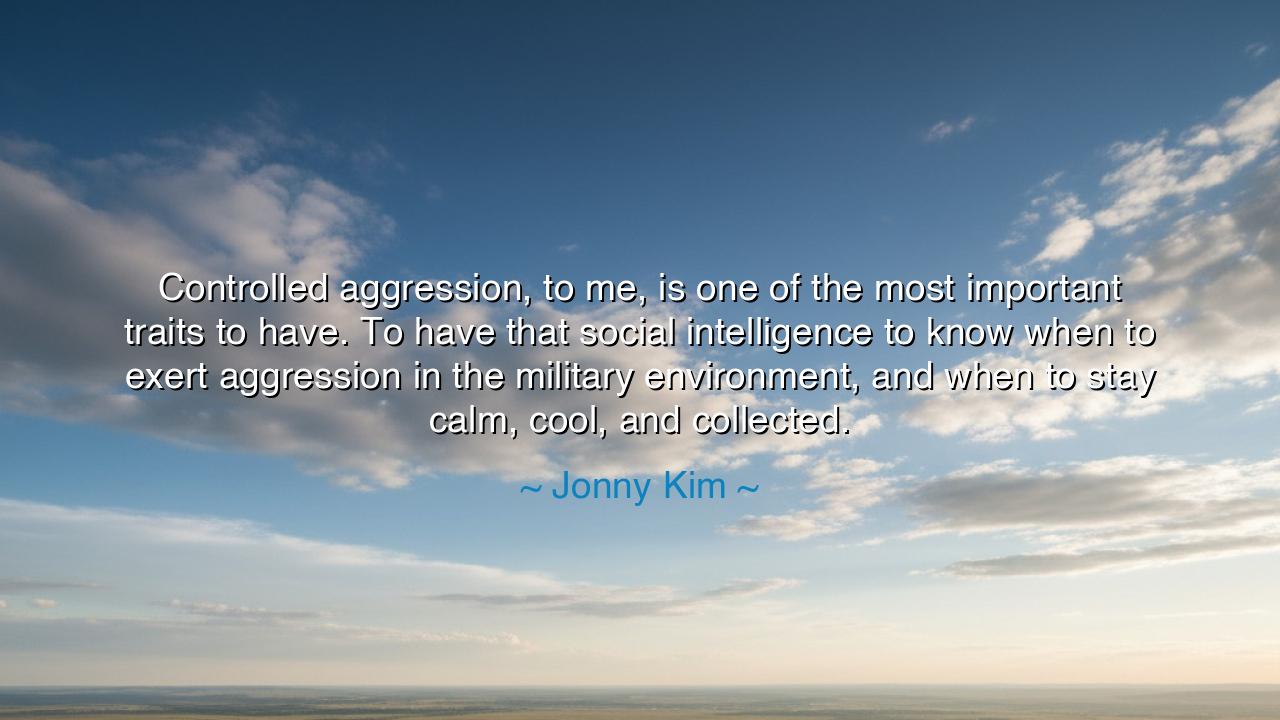
Controlled aggression, to me, is one of the most important traits
Controlled aggression, to me, is one of the most important traits to have. To have that social intelligence to know when to exert aggression in the military environment, and when to stay calm, cool, and collected.






In the battlefields of life, both literal and metaphorical, the art of controlled aggression stands as a pillar of strength and wisdom. Jonny Kim, a man who embodies the virtues of both military service and social intelligence, encapsulates a profound truth when he says, “Controlled aggression, to me, is one of the most important traits to have. To have that social intelligence to know when to exert aggression in the military environment, and when to stay calm, cool, and collected.” These words speak to the delicate balance between strength and restraint, between action and patience—qualities that are vital not only in the heat of battle but in all aspects of life.
In the ancient world, warriors were revered not just for their strength, but for their wisdom in knowing when to strike and when to hold back. The Samurai of Japan, for example, practiced the art of bushido, the way of the warrior, which emphasized discipline, respect, and controlled aggression. It was said that a true warrior did not fight out of anger or rashness but used aggression as a tool, directed only when necessary to protect honor, life, and the greater good. The warrior’s strength was in their ability to remain calm amidst chaos, making decisions with clarity and purpose, rather than being consumed by passion or recklessness.
Similarly, consider the life of Alexander the Great, whose conquests stretched across the known world. Known for his audacity and determination, Alexander was also a leader who understood the importance of strategic action. There were times when he needed to exert relentless force and aggression to overcome his enemies, but there were also times when restraint was required, as seen in his many political maneuvers and alliances. Alexander’s success was not just in his ability to conquer, but in his mastery of when and how to apply his aggression, knowing that sometimes the greatest victories come not from battle, but from strategic calm.
Jonny Kim’s understanding of controlled aggression echoes a similar wisdom. Aggression, when unchecked, can lead to destruction—of oneself, of others, and of the very purpose one seeks to achieve. But when it is channeled and directed with precision, it becomes a formidable tool for accomplishing one’s goals. In a military environment, as Kim suggests, the ability to assess the situation, to know when to push forward with force and when to remain calm, is the mark of a true leader. A leader who is reactive, who allows their emotions to dictate their actions, will often find themselves lost in the chaos of the moment. But a leader who remains cool and collected, knowing when to strike and when to hold back, is a force that cannot easily be defeated.
This wisdom is not only applicable to the battlefield but to everyday life. Controlled aggression is a trait that we can all cultivate, whether in our careers, relationships, or personal development. Life often demands that we face challenges with strength and resolve, but it also calls for moments of patience and restraint. How often do we find ourselves in situations where a surge of emotion threatens to dictate our actions, when anger, impatience, or fear might drive us to make hasty decisions? It is in those moments that we must tap into the wisdom of controlled aggression—to know that true power lies in our ability to remain focused, composed, and strategic.
The lesson here is one of balance—between strength and wisdom, between action and restraint. Controlled aggression is not about suppressing one’s emotions, but about channeling them in a way that serves a greater purpose. It is the warrior’s way, the leader’s way, and the way of anyone who wishes to navigate the complexities of life with grace and power. To apply this wisdom in our own lives, we must first recognize the moments when we need to push forward with vigor, and when we need to pause and assess the situation, allowing our calmness to guide us toward the right action.
Let us take the example of Jonny Kim, a man who has served as a Navy SEAL, a doctor, and a leader. His life is a testament to the power of controlled aggression—the ability to maintain focus, remain calm in the most difficult situations, and take decisive action when the time is right. We too can apply this wisdom, in all aspects of our lives, by learning to act with purpose, not out of impulse, and to respond with intelligence, rather than reaction. When we are able to master this balance, we unlock the true power of strength, knowing that true power is not always in the force of our actions, but in the clarity with which we choose to act.
In our journey forward, let us remember the wisdom of controlled aggression. Let us learn to master our impulses, to act not from a place of unchecked emotion, but from a place of strategic calm and wisdom. Whether in moments of challenge or in the quiet decisions of daily life, let our strength be directed with purpose, knowing when to exert power and when to step back. In doing so, we shape not just our own future, but the world around us.






AAdministratorAdministrator
Welcome, honored guests. Please leave a comment, we will respond soon